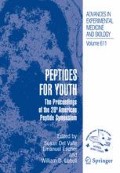Keywords
These keywords were added by machine and not by the authors. This process is experimental and the keywords may be updated as the learning algorithm improves.
Introduction
The neurohypophyseal hormone, 8-arginine-vasopressin (AVP, 1), produces arterial vasoconstriction by activation of the V1a vasopressin receptor (V1aR) located in vascular smooth muscle. This vasopressor effect can be used to treat vasodilatory hypotension in critical care and other conditions [1]. AVP is the endogenous ligand for the V1aR and the two additional vasopressin receptors (V1bR and V2R), and also binds to the oxytocin receptor (OTR). When used as a vasopressor, the lack of selectivity of AVP could possibly generate unwanted side effects such as V2 receptor mediated antidiuresis and release of coagulation factors. In order to find new, more V1a selective agonists, analogs of 1 of the general structure [X2,Ile3,Y4,Z8]VP have been designed, synthesized and tested in vitro.
Results and Discussion
Enhanced selectivity towards V1aR in a rat in vivo model for [Phe2,Ile3,Orn8]VP, 2, was first reported by Huguenin [2]. The peptide was tested in our in vitro RGA assays and showed improved selectivity versus related receptors as compared to 1 (see table 1). It was also demonstrated that the Ferring compound, [Hmp1,Phe2,Ile3, Hgn4,Orn(Dab)8]VP (F-180), is a potent and selective V1a receptor agonist [3]. Therefore, all new analogs were designed with the Ile3 residue and positions 2, 4 and 8 were selected for modifications.
The analogs with an N-ω-alkylated diamino acid residue in position 8 were prepared by Fmoc SPPS. The Mtt group was employed for the side chain amino group protection. After peptide assembly the Mtt group was removed with 1% TFA/DCM. Reductive alkylation with acetone/NaBH(OAc)3 provided the N-isopropyl peptides. To obtain N-alkyl analogs with non-branched alkyl groups, the o-nitrobenzenesulfonyl group (o-NBS) [4] was transiently introduced and the intermediate sulfonamide was alkylated with an appropriate alcohol under Mitsunobu reaction conditions. The o-NBS group was removed with 5% potassium thiophenolate in DMF, and the peptides were cleaved from the resin with TFA.
The analogs containing ω-amides of Asp or Glu in position 4 were synthesized by Boc strategy. The dicarboxylic amino acid residue was introduced in the sequence as Boc-Aaa(OFm)-OH. After peptide assembly the side chain protection was removed with 30% piperidine in DMF. The resulting free carboxylic group was converted to the desired amide by coupling with an appropriate amine mediated by PyBOP/DIEA. The N-terminal Boc group was then removed and the peptides were cleaved with HF. All linear analogs were cyclized with iodine and purified by HPLC.
Analogs, where X is a residue containing a small unsubstituted heteroaromatic ring (e.g. 3-Thi, 6), do not show an improved pharmacological profile over the Phe2 peptides, and the 2-furylalanine2 (Ala(2-Fur)) compounds (i.e. 3) are less potent than their Phe2 counterparts. When the heteroaromatic ring in position 2 contains nitrogen (e.g. X = 3-Pal, compound 5), there is a significant loss of potency at the hV1aR as compared to 1 or 2. Position 4 seems to be the key one to attain high selectivities versus both hV2R and hOTR. The much desired V2 selectivity can be tuned by changing the position 4 side chain lengths as exemplified by analogs 7 and 11 or by alkylating the primary amide functionality (compounds 8 (Y = Asn(Me2) and 9 (Y = Asn(Et)). Replacing the Orn8 residue with diaminobutyric acid (Z = Dab) appears to have a deteriorating effect on the overall selectivity as exemplified by analogs 4 and 6. The N-alkylation of the Orn side chain (Z = Orn(Me) or Orn(iPr), compounds 10 and 11) provides improved selectivity towards hV1bR that couldn't be achieved by any other modifications described in this paper. Combining selected modifications in positions 2, 4 and 8 resulted in potent and selective peptidic V1a agonists exemplified by compounds 7 through 11.
In conclusion, new V1a selective AVP analogs with in vitro pharmacological profile superior to AVP are described.
References
Landry, D. W., Levin, H. R., Gallant, E. M., Ashton, R. C. Jr., Seo, S., D'Alessandro, D., Oz, M. C. and Oliver, J. A., Circulation, 95, 1122–1125 (1997).
Huguenin, R. L., Helv. Chim. Acta, 47, 1934–1941 (1964).
Andres, M., Trueba, M. and Guillon, G., Br. J. Pharm. 135, 1828–1836 (2002).
Fukuyama, T., Jow, C.-K. and Cheung, M., Tetrahedron Lett. 36, 6373–6374 (1995).
Acknowledgments
he authors wish to thank Marlene Brown and Monica Wolfe for their excellent technical assistance.
Author information
Authors and Affiliations
Editor information
Editors and Affiliations
Rights and permissions
Copyright information
© 2009 Springer Science+Business Media, LLC
About this paper
Cite this paper
Wisniewski, K. et al. (2009). Synthesis and in vitro Pharmacological Profile of Potent and Selective Peptidic V1a Receptor Agonists.. In: Valle, S.D., Escher, E., Lubell, W.D. (eds) Peptides for Youth. Advances in Experimental Medicine and Biology, vol 611. Springer, New York, NY. https://doi.org/10.1007/978-0-387-73657-0_220
Download citation
DOI: https://doi.org/10.1007/978-0-387-73657-0_220
Publisher Name: Springer, New York, NY
Print ISBN: 978-0-387-73656-3
Online ISBN: 978-0-387-73657-0
eBook Packages: Chemistry and Materials ScienceChemistry and Material Science (R0)

